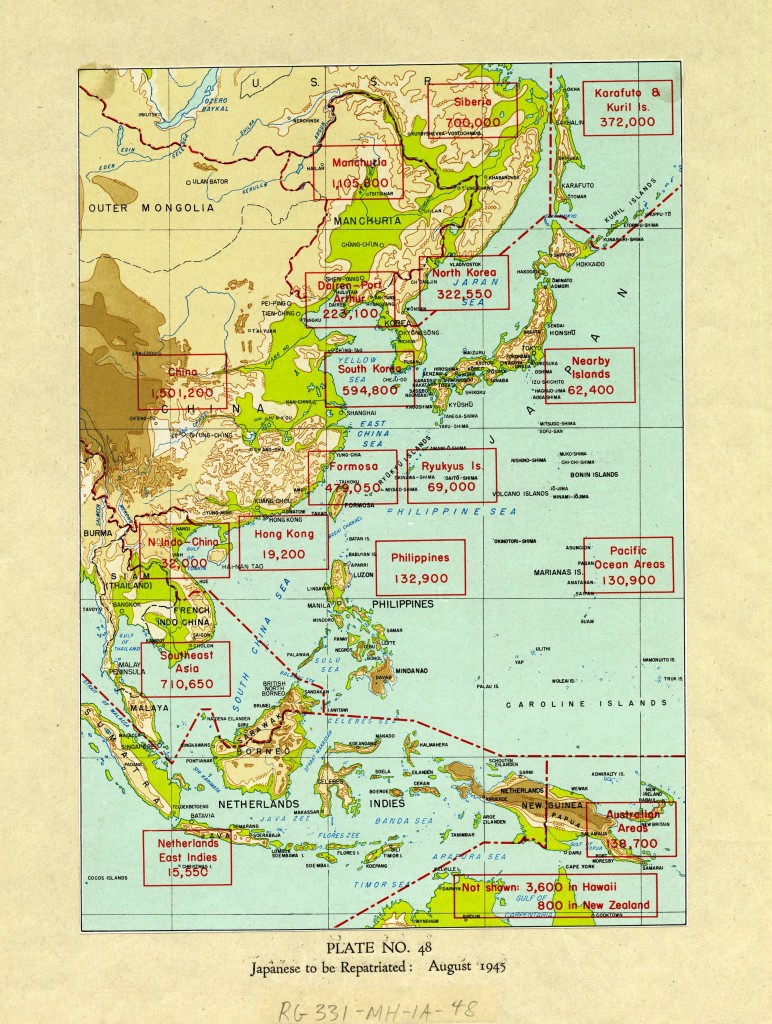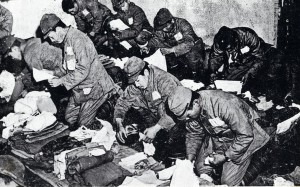Three Million Japanese Go Home
- By Peter Harmsen
- 6 November, 2013
- 24 Comments
 Three million — that’s the number of Japanese who had to be repatriated from areas traditionally considered Chinese at the end of the war in 1945. They included 2.6 million on the Chinese mainland, with 1.1 million in the northeastern provinces known then as Manchuria, and 1.5 million in the other areas. In addition, there were nearly half a million in Taiwan, which was called Formosa in the west and had been a Japanese colony since the end of the First Sino-Japanese War in 1895. This is illustrated in a map prepared by General Douglas MacArthur’s staff in the late 1940s (pictured to the left), when the US war hero was still running post-war Japan. The map, part of a history project carried out by the staff, was made available on the Internet for the first time in August by Japan’s National Diet Library.
Three million — that’s the number of Japanese who had to be repatriated from areas traditionally considered Chinese at the end of the war in 1945. They included 2.6 million on the Chinese mainland, with 1.1 million in the northeastern provinces known then as Manchuria, and 1.5 million in the other areas. In addition, there were nearly half a million in Taiwan, which was called Formosa in the west and had been a Japanese colony since the end of the First Sino-Japanese War in 1895. This is illustrated in a map prepared by General Douglas MacArthur’s staff in the late 1940s (pictured to the left), when the US war hero was still running post-war Japan. The map, part of a history project carried out by the staff, was made available on the Internet for the first time in August by Japan’s National Diet Library.
A large component of civilians demonstrates that Japan had planned to stay in China more or less permanently, building up a colonial administration modeled on the older European empires in Asia. Significantly, the longer the Japanese had statyed in a place, the larger the percentage of civilians — typically officials, engineers, merchants and farmers. In Taiwan, where the Japanese presence was half a century old, civilians made up 63.7 percent of the total number of Japanese nationals, also according to data from MacArthur’s staff made public by the National Diet Liberary this August. In Manchuria, under Japanese control since 1931, they constituted 56.8 percent. And in the rest of China, where war was still very much a fact of daily life, they were a smaller minority of just 27.8 percent.

Japanese soldiers preparing to be repatriated from Shanghai in 1945
Repatriating this large number of Japanese was a major logistical undertaking, made all the more difficult by the fact that much of Japan’s surface fleet, military and merchant, had been sent to the bottom of the ocean by the hugely efficient US submarine force. What is most remarkable, however, was the relative lack of violence, at least on a mass scale, accompanying the ouster of the Japanese. This is particularly striking when comparing with the situation at about the same time in Europe, where ethnic Germans were being expelled from their homes across Eastern and Central Europe in conditions that were often extremely brutal. This brutality was of course explained by the atrocity-prone Nazi administration that had governed much of Eastern Europe in the war years, and therefore, what needs to be explained is not so much the presence of violence in Europe, but rather its comparative absence in Asia.

 Copyright © 2025
Copyright © 2025
Leave a Reply